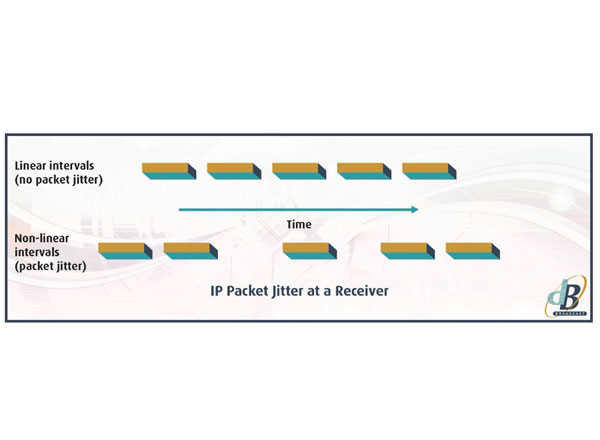Broadcast News
08/08/2018
Jitter And Network Performance In Broadcast Networks

In this article, dB Broadcast discusses the causes of IP jitter and its impact on broadcast network performance. dB Broadcast has extensive experience in designing and implementing innovative IP solutions for clients such as Bloomberg Television and BBC Wales.
In an ideal IP network carrying constant bitrate data, jitter is any deviation from the regularity or "linearity" of the arrival times of IP packets at a receiver. This can be caused by improper router or switch configuration or queueing issues, but if the routers and switches are operating correctly, the most common cause of jitter is network congestion at router and switch interfaces.
As IP networks are asynchronous some jitter is inherent, but to optimise network performance and minimise jitter, senders should ideally transmit IP packets in as linear a fashion as possible. Applications within network elements are likely to require the data to be non-bursty, and to achieve this, receivers implement a "de-jitter" buffer. Packets flow out of the buffer at a regular rate, removing the jitter from the packets flowing into the buffer from the interface. The application then receives de-jittered packets from the output of this buffer rather than directly from the interface.
What is the impact of excessive packet jitter?
In the previous section, we saw that packets flow out of a receiver's de-jitter buffer at a steady rate known as the "drain rate", with the rate at which a buffer receives data being known as the "fill rate".
Selecting the size of this buffer is important for two reasons:
• If the drain rate exceeds the fill rate, then it is possible that too small a buffer could underflow, resulting in stalled packet flow. Likewise, if the fill rate exceeds the drain rate, then at some point the buffer will overflow, resulting in packet loss.
• However, if the buffer size is too large, then the network element will introduce excessive latency.
Network jitter causes the packet arrival intervals at a receiver to become non-linear, and the buffer fill rate will no longer be constant. As the jitter becomes greater, the variability of the buffer fill rate becomes greater. At some point this will lead to the condition where the buffer's fill and drain rates become so uneven that the buffer will either underflow leading to stalling, or overflow leading to packet loss. Both stalling and packet loss will lead to impaired video.
What else causes packet loss?
If the network is experiencing packet loss, and if jitter levels are excessive, then it is likely that network congestion is significant enough to be causing the packet loss. However, if jitter levels are acceptable and the system is experiencing packet loss, network congestion is unlikely to be the cause, which is more likely to be port over-subscription.
What is the impact of non-linear data flows on network performance?
With SMPTE ST 2022-6 the data flows are linear, as the data rate is that of the entire SDI payload, which is always of constant bit-rate. With SMPTE ST 2110 only the active video is transmitted and the HANC and VANC data is not transmitted. There are two possible modes of transmission defined by SMPTE ST2110-21 (which is commonly referred to as "traffic shaping"). The first is the "linear" mode or PRS (Packet Read Schedule) as it is referred to. When a linear PRS is used, packets containing only the active video are transmitted by the sender at even intervals for the duration of the whole frame, resulting in a constant bit-rate transmission of just over 1 Gbps.
The second mode is known as the "gapped" PRS, where the sender transmits the active video packets in a linear fashion, but transmits nothing during the period corresponding to the VANC interval. This of course results in an inherently bursty (non-linear) variable bit-rate transmission of between 0 Gbps and more than 1.5 Gbps. The average bit-rate is the same as for the linear PRS at just over 1 Gbps. This burstiness is, as we discussed earlier, undesirable from a network perspective, as the impact on the network is the same as if the linear data flow was subject to bursty jitter caused by network congestion.
The burstiness must be handled by buffering the flow, to ensure that the packet flow is linear enough to avoid buffer underflows and overflows. However, increasing the buffer size when compared with that required for the linear PRS, leads to a corresponding increase in latency.
When implementing broadcast networks where a SMPTE ST 2110 gapped PRS is used, system integrators need to pay special attention to network congestion and jitter in the video data flows. They must ensure that any jitter does not result in excessive non-linearity, causing the router and switch buffers to become overwhelmed, resulting in packet loss.
dbbroadcast.co.uk
This article is also available in the August edition of Broadcast Film & Video. Available here.
In an ideal IP network carrying constant bitrate data, jitter is any deviation from the regularity or "linearity" of the arrival times of IP packets at a receiver. This can be caused by improper router or switch configuration or queueing issues, but if the routers and switches are operating correctly, the most common cause of jitter is network congestion at router and switch interfaces.
As IP networks are asynchronous some jitter is inherent, but to optimise network performance and minimise jitter, senders should ideally transmit IP packets in as linear a fashion as possible. Applications within network elements are likely to require the data to be non-bursty, and to achieve this, receivers implement a "de-jitter" buffer. Packets flow out of the buffer at a regular rate, removing the jitter from the packets flowing into the buffer from the interface. The application then receives de-jittered packets from the output of this buffer rather than directly from the interface.
What is the impact of excessive packet jitter?
In the previous section, we saw that packets flow out of a receiver's de-jitter buffer at a steady rate known as the "drain rate", with the rate at which a buffer receives data being known as the "fill rate".
Selecting the size of this buffer is important for two reasons:
• If the drain rate exceeds the fill rate, then it is possible that too small a buffer could underflow, resulting in stalled packet flow. Likewise, if the fill rate exceeds the drain rate, then at some point the buffer will overflow, resulting in packet loss.
• However, if the buffer size is too large, then the network element will introduce excessive latency.
Network jitter causes the packet arrival intervals at a receiver to become non-linear, and the buffer fill rate will no longer be constant. As the jitter becomes greater, the variability of the buffer fill rate becomes greater. At some point this will lead to the condition where the buffer's fill and drain rates become so uneven that the buffer will either underflow leading to stalling, or overflow leading to packet loss. Both stalling and packet loss will lead to impaired video.
What else causes packet loss?
If the network is experiencing packet loss, and if jitter levels are excessive, then it is likely that network congestion is significant enough to be causing the packet loss. However, if jitter levels are acceptable and the system is experiencing packet loss, network congestion is unlikely to be the cause, which is more likely to be port over-subscription.
What is the impact of non-linear data flows on network performance?
With SMPTE ST 2022-6 the data flows are linear, as the data rate is that of the entire SDI payload, which is always of constant bit-rate. With SMPTE ST 2110 only the active video is transmitted and the HANC and VANC data is not transmitted. There are two possible modes of transmission defined by SMPTE ST2110-21 (which is commonly referred to as "traffic shaping"). The first is the "linear" mode or PRS (Packet Read Schedule) as it is referred to. When a linear PRS is used, packets containing only the active video are transmitted by the sender at even intervals for the duration of the whole frame, resulting in a constant bit-rate transmission of just over 1 Gbps.
The second mode is known as the "gapped" PRS, where the sender transmits the active video packets in a linear fashion, but transmits nothing during the period corresponding to the VANC interval. This of course results in an inherently bursty (non-linear) variable bit-rate transmission of between 0 Gbps and more than 1.5 Gbps. The average bit-rate is the same as for the linear PRS at just over 1 Gbps. This burstiness is, as we discussed earlier, undesirable from a network perspective, as the impact on the network is the same as if the linear data flow was subject to bursty jitter caused by network congestion.
The burstiness must be handled by buffering the flow, to ensure that the packet flow is linear enough to avoid buffer underflows and overflows. However, increasing the buffer size when compared with that required for the linear PRS, leads to a corresponding increase in latency.
When implementing broadcast networks where a SMPTE ST 2110 gapped PRS is used, system integrators need to pay special attention to network congestion and jitter in the video data flows. They must ensure that any jitter does not result in excessive non-linearity, causing the router and switch buffers to become overwhelmed, resulting in packet loss.
dbbroadcast.co.uk
This article is also available in the August edition of Broadcast Film & Video. Available here.
Useful Links
Top Related Stories
Click here for the latest broadcast news stories.
04/11/2010
OASYS Appoints The VAR Network To Expand Dealer Network
OASYS, a leading developer of IT-based automated playout solutions, has announced that it has appointed The VAR Network to develop and manage its Euro
OASYS Appoints The VAR Network To Expand Dealer Network
OASYS, a leading developer of IT-based automated playout solutions, has announced that it has appointed The VAR Network to develop and manage its Euro
07/11/2023
Ruijie Network Joins SDVoE Alliance
Ruijie Network has joined the SDVoE Alliance as an adopting member. Ruijie Network specializes in the research, development, design and sales of netwo
Ruijie Network Joins SDVoE Alliance
Ruijie Network has joined the SDVoE Alliance as an adopting member. Ruijie Network specializes in the research, development, design and sales of netwo
16/04/2007
OmniTek Demonstrate Eye & Jitter Analysis Solution At NAB 2007
OmniTek will demonstrate its new high-performance eye pattern and jitter analysis module, which will be on view for the first time at NAB 2007. The ne
OmniTek Demonstrate Eye & Jitter Analysis Solution At NAB 2007
OmniTek will demonstrate its new high-performance eye pattern and jitter analysis module, which will be on view for the first time at NAB 2007. The ne
19/02/2014
Video And Audio Using IP: How The LiveShot And Access Do It
How to make IP work to your advantage, by Ian Prowse of Vortex Communications. Imagine a balloon full of water; front to back represents delay, left t
Video And Audio Using IP: How The LiveShot And Access Do It
How to make IP work to your advantage, by Ian Prowse of Vortex Communications. Imagine a balloon full of water; front to back represents delay, left t
02/03/2005
QuVIS servers selected for groundbreaking 250-screen digital network
Following an extensive evaluation and competitive bid process, QuVIS servers will be installed by Arts Alliance Digital Cinema for the UK Film Council
QuVIS servers selected for groundbreaking 250-screen digital network
Following an extensive evaluation and competitive bid process, QuVIS servers will be installed by Arts Alliance Digital Cinema for the UK Film Council
23/02/2005
TMD chosen by Ascent Media Network to supply media workflow system for five
TMD Ltd has won a major contract to supply and implement its Mediaflex Media Asset Management and Workflow system for Ascent Media Network Services Eu
TMD chosen by Ascent Media Network to supply media workflow system for five
TMD Ltd has won a major contract to supply and implement its Mediaflex Media Asset Management and Workflow system for Ascent Media Network Services Eu
08/02/2005
NECN opts for Network Electronics routers
NECN (New England Cable News), the largest regional cable news network in the US, is using routers from Network Electronics’ compact VikinX range to r
NECN opts for Network Electronics routers
NECN (New England Cable News), the largest regional cable news network in the US, is using routers from Network Electronics’ compact VikinX range to r
01/02/2005
ETTV chooses Network Electronics for signal transport
Following an extensive evaluation of competitive products, ETTV - Taiwan’s largest shopping network - has selected a complex flashlink optical transpo
ETTV chooses Network Electronics for signal transport
Following an extensive evaluation of competitive products, ETTV - Taiwan’s largest shopping network - has selected a complex flashlink optical transpo
07/01/2005
Network Electronics opens new China office
Network Electronics’ considerable success in the growing Chinese broadcast market has resulted in the Norwegian manufacturer to open its second office
Network Electronics opens new China office
Network Electronics’ considerable success in the growing Chinese broadcast market has resulted in the Norwegian manufacturer to open its second office
16/11/2004
Network Electronics help upgrade Korea Telecom's Satellite Operations division
Korea Telecom (KT) has installed a fully-redundant Network Electronics flashlink fibre optic transport platform in its Satellite Operations division,
Network Electronics help upgrade Korea Telecom's Satellite Operations division
Korea Telecom (KT) has installed a fully-redundant Network Electronics flashlink fibre optic transport platform in its Satellite Operations division,
15/11/2004
CinemaNet Europe documentary network launched
Docspace Chairperson Amy Hardie has described CinemaNet Europe, the recently launched pan-European documentary network, as "The most exciting venture
CinemaNet Europe documentary network launched
Docspace Chairperson Amy Hardie has described CinemaNet Europe, the recently launched pan-European documentary network, as "The most exciting venture
29/10/2004
Scientific-Atlanta adds Techex to European Distributor Network
Scientific-Atlanta has expanded its presence in the UK marketplace with the addition of Techex as their latest distributor for content distribution an
Scientific-Atlanta adds Techex to European Distributor Network
Scientific-Atlanta has expanded its presence in the UK marketplace with the addition of Techex as their latest distributor for content distribution an
27/10/2004
AZCAR awarded consulting contract for Sky Network Television of New Zealand
Stephen Pumple, President & CEO of AZCAR Technologies Incorporated, has announced that the company has been selected as the consultants to Sky Network
AZCAR awarded consulting contract for Sky Network Television of New Zealand
Stephen Pumple, President & CEO of AZCAR Technologies Incorporated, has announced that the company has been selected as the consultants to Sky Network
20/10/2004
Network Electronics VikinX joins AMX Inconcert Programme
Network Electronics’ comprehensive VikinX router range has further extended its reach through membership in the AMX Corporation Inconcert Programme. T
Network Electronics VikinX joins AMX Inconcert Programme
Network Electronics’ comprehensive VikinX router range has further extended its reach through membership in the AMX Corporation Inconcert Programme. T
13/10/2004
Snell & Wilcox IQ solutions to serve as backbone for new Turner HD network
Turner Entertainment Group, the world's largest broadcast system with integrated monitoring and control capabilities, has selected Snell & Wilcox IQ M
Snell & Wilcox IQ solutions to serve as backbone for new Turner HD network
Turner Entertainment Group, the world's largest broadcast system with integrated monitoring and control capabilities, has selected Snell & Wilcox IQ M















